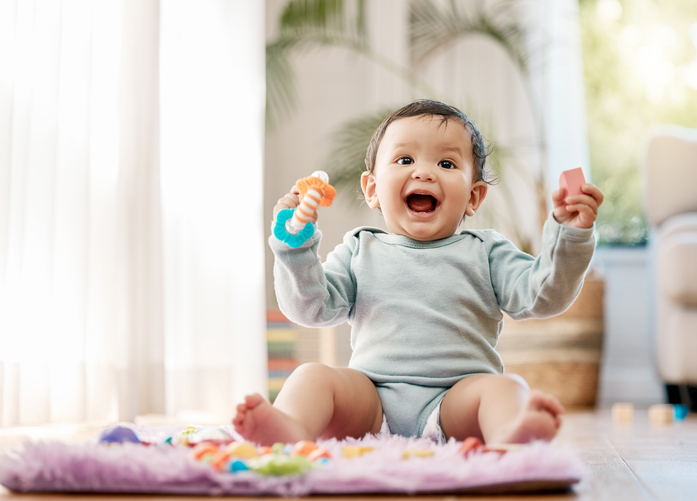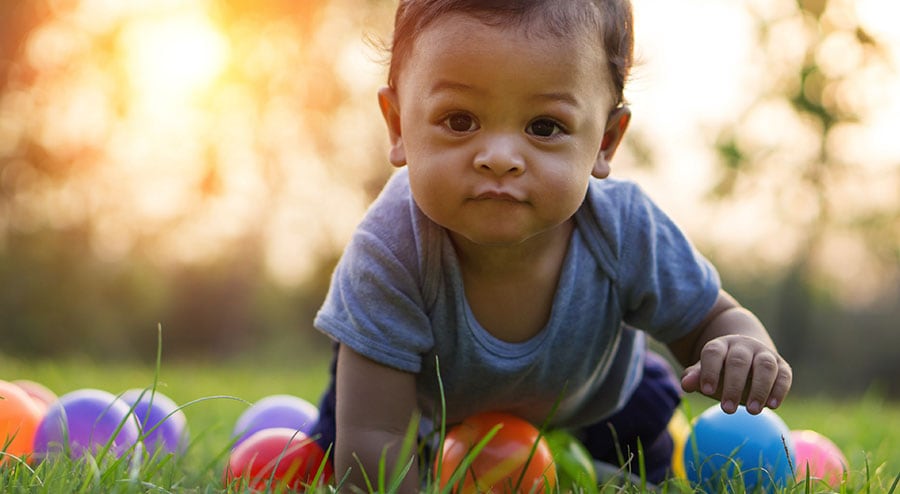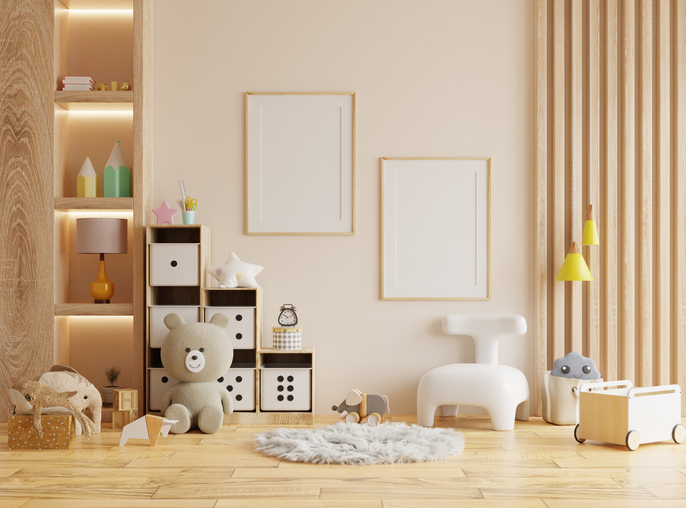Play is a fundamental part of growth and development and ensuring safe and age-appropriate toy selection for infants should be a top priority. As such, safe toy selection includes but is not limited to understanding age-appropriate toys that align with an infant’s developmental stages, selecting non-toxic toys that are free from harmful chemicals and materials, and addressing common choking hazards in toys. By being aware of toy size and design, parents can create a play environment that promotes exploration without compromising an infant’s safety.
Understanding the process of safe toy selection, including cognitive, and physical development toys, DIY ideas, inclusivity, battery-operated toys, and the importance of regular toy maintenance allows parents to have the knowledge and resources to make informed choices, and provide their children with security through play.

Table of Contents
- Understanding Safe Toy Selection for Infants
- Ensuring Non-Toxic Toys for Your Infant
- Choking Hazards and Safe Toy Size
- Popular Infant Toys and Their Safety
- Stimulating Development with Safe Toys
- Special Considerations and Inclusivity
- Battery-Operated Toys and Electronics
- DIY Toy Ideas for Infants
- Toy Maintenance and Replacement
- Brands and Resources for Safe Toy Selection
- Take Away
Understanding Safe Toy Selection for Infants
Understanding the appropriate age range is fundamental to ensuring their safety and promoting healthy development when selecting toys for infants. Age-appropriate toys are specifically designed to align with an infant’s current stage of growth and capabilities. As they progress through different developmental milestones, their needs and interests change, and the right toys can provide valuable learning experiences.
For example, for newborns up to three months old, toys that engage their senses, such as soft and colorful mobiles or plush rattles, are ideal choices. These toys stimulate their visual and auditory senses, fostering early cognitive development. As infants reach the age of six to twelve months, they become more curious and begin exploring with their hands and mouths. At this stage, toys like teething rings, stacking cups, and activity play mats become more suitable options, encouraging sensory exploration, hand-eye coordination, and motor skills.
Be sure to consider the developmental stages of infants when selecting toys, as providing toys that are too advanced or not appropriate for their current abilities may lead to frustration or potential hazards. By matching toys to an infant’s stage of development, caregivers can create an enriching and safe play environment that nurtures their growth and curiosity. Always remember to check the recommended age range on toy labels and choose toys that align with the specific needs and capabilities of the child.
Ensuring Non-Toxic Toys for Your Infant
Potential hazards that may exist include small parts, loose components, or detachable pieces in toys as they can pose serious choking hazards for young children who tend to explore objects by putting them in their mouths. Caregivers should be diligent in inspecting toys and avoiding those with small parts that could accidentally come loose during play.
Additionally, the materials used in the manufacturing of toys play a crucial role in ensuring their non-toxicity. Toxic substances such as BPA, phthalates, and PVC can be harmful to an infant’s health if ingested or exposed to their skin. To mitigate this risk, look for toys that are labeled as “BPA-free” or “phthalate-free” to ensure they do not contain these harmful chemicals.
One reputable brand known for producing non-toxic toys is “PlanToys.” They utilize sustainable and eco-friendly materials, such as chemical-free rubberwood and non-toxic water-based dyes, in their toy production. Their “PlanToys First Stacking Ring ($17.99)” is a popular choice for infants aged six months and above, promoting hand-eye coordination and problem-solving skills.
Another brand that prioritizes toy safety is “Hape.” Their toys are made from high-quality, non-toxic wood and water-based paints, ensuring a safe play experience for infants. The “Hape Double Bubble Wooden Bead Maze ($19.99)” is a suitable option for infants aged twelve months and above, encouraging fine motor skills and exploration.
Being aware of potential hazards and choosing toys from reputable brands that prioritize non-toxic materials allows caregivers to create a safe and enriching play environment for their infants. Being informed about specific safety certifications to look for provides an added layer of assurance that the selected toys meet essential safety standards.
Choking Hazards and Safe Toy Size
Young children have a natural inclination to explore their environment through mouthing objects, which increases the risk of swallowing small parts that can block their airways. Common choking hazards in toys include small balls, detachable pieces, or toys with loose parts that can be easily dislodged. It is crucial for caregivers to carefully examine toys and avoid those with components that could potentially pose such risks.
When inspecting toys for potential choking hazards, it is essential to consider the size of the toy and its parts. As a general rule, any object that can pass through a standard toilet paper roll poses a choking hazard for infants. Caregivers should avoid toys with small parts that could fit through this cylinder as they are unsafe for young children. Additionally, toys that have parts securely attached and cannot be easily pulled apart are a safer choice.
One brand that emphasizes safe toy size and design is “Fisher-Price.” Their “Fisher-Price Brilliant Basics Baby’s First Blocks” is suitable for infants aged six months and above. This toy features large, brightly colored blocks that are easy for infants to grasp and manipulate. The blocks fit perfectly into a matching sorting bucket, ensuring that all pieces are securely stored and reducing the risk of small parts becoming loose. Another brand and toy known to be safe and age-appropriate toys is the “Melissa & Doug First Play Safari Zig-Zag Tower ($14.99)” which is designed for infants aged twelve months and above. This wooden toy features chunky, animal-themed pieces that slide along tracks, providing a fun and safe way for infants to explore movement and hand-eye coordination.
Avoid compromising your infant’s safety by being vigilant about common choking hazards and following guidelines for safe toy size. Choosing toys with age-appropriate designs and securely attached components ensures that playtime remains enjoyable and risk-free.
Popular Infant Toys and Their Safety
As infants grow and explore their surroundings, certain toys become more popular due to their engaging features and sensory appeal. However, it is essential to be aware of potential safety concerns associated with some of these toys. One such toy that caregivers should be cautious about is the “Bead Maze” or “Bead Roller Coaster” type of toy. While they may seem entertaining and colorful, these toys often feature small beads that can pose choking hazards if they detach from their tracks. Caregivers should ensure that the beads are securely attached and cannot be easily pulled off.
Another popular but potentially hazardous toy is the “Squeeze Toy” or “Squeaky Toy.” These toys typically produce sounds when squeezed, which may attract infants’ attention. However, some of these toys have squeakers or noisemakers inside that can be small enough to present a choking hazard if accessed. To avoid this risk, caregivers can opt for larger plush squeaky toys that do not have removable parts, ensuring a safer play experience.
For safer alternatives, “Lamaze” offers a variety of sensory and developmental toys specifically designed for infants. Their “Lamaze Freddie The Firefly” is a beloved option, featuring multiple textures, colors, and crinkly wings that stimulate a baby’s senses. It also includes a secure teething ring for soothing discomfort during teething. This toy is suitable for infants aged zero to six months.
Another recommended alternative is the “Skip Hop Explore & More Follow Bee Crawl Toy ($25.99).” This interactive toy encourages crawling and features colorful lights, music, and movement to captivate infants’ attention. Its unique design and age-appropriate features make it suitable for babies aged five months and above.
Make conscious decisions about toys and their alternatives when selecting toys in order to provide your child with safer alternatives that promote development and exploration without compromising their well-being.
Stimulating Development with Safe Toys
Choosing toys that promote sensory, cognitive, and physical development is a crucial aspect of safe toy selection for infants. For sensory development, toys that engage an infant’s senses of sight, touch, and hearing are highly beneficial. Brands like “Manhattan Toy” offer a range of sensory toys, including the “Winkel Rattle and Sensory Teether Toy.” This colorful toy features soft, BPA-free loops that are easy for infants to grasp, promoting hand-eye coordination and tactile exploration. The gentle rattling sound it produces enhances auditory stimulation, making it suitable for infants aged zero to twelve months.
For cognitive development, “Fisher-Price” offers the “Laugh & Learn Smart Stages Chair ($34.99),” designed for infants aged twelve months and above. This interactive toy chair introduces infants to numbers, shapes, and colors while encouraging curiosity and exploration. The chair has three different levels of play, adjusting to an infant’s developmental stage and providing continuous learning opportunities.
In terms of physical development, toys that encourage movement and motor skills are ideal. One such option is the “VTech Sit-to-Stand Learning Walker,” suitable for infants aged nine months and above. This versatile toy assists infants in learning to stand and take their first steps. It also features interactive buttons, gears, and shape sorters that promote fine motor skills and imaginative play.
The listed examples offer safe and age-appropriate ways to stimulate sensory, cognitive, and physical development in infants, allowing them to explore and discover the world around them while staying safe and engaged.
Special Considerations and Inclusivity
When it comes to safe toy selection for infants, it is essential to consider the diverse needs and abilities of all children, including those with special requirements or disabilities. Inclusivity in toy selection ensures that every child can actively participate in play and exploration. For infants with visual impairments, toys with high-contrast colors and textures, such as the “Sassy Developmental Bumpy Ball,” can be beneficial. This toy features bold patterns and different textures, stimulating sensory exploration and enhancing an infant’s tactile experiences.
For infants with hearing impairments, “Fisher-Price” offers the “Bright Beats Dance & Move BeatBo.” This interactive toy features colorful lights and vibrant dance moves that captivate infants, making it engaging for those with various sensory abilities. The toy also includes buttons for infants to press, introducing cause-and-effect relationships and encouraging hand movements.
Inclusive toy selection extends beyond sensory considerations to encompass toys that accommodate various physical abilities. For example, the “Fat Brain Toys Dimpl Duo” is a suitable option for infants with limited hand strength or motor challenges. This toy features silicone buttons that are easy to push, promoting fine motor skills and sensory exploration.
Being mindful of toys that cater to diverse needs and abilities contributes to creating an inclusive and nurturing play environment for every child and fosters a sense of belonging and promotes their overall development.
Battery-Operated Toys and Electronics
Battery-operated toys and electronic gadgets can be appealing to both infants and parents due to their interactive features and entertainment value. However, caregivers should exercise caution and be aware of potential concerns associated with such toys. First and foremost, it is essential to check the recommended age range on the packaging to ensure that the toy is suitable for an infant’s developmental stage. Toys designed for older children may have small parts or features that could pose choking hazards for infants.
Furthermore, caregivers should pay attention to the type of batteries used in these toys. It is advisable to opt for toys that use securely enclosed battery compartments, reducing the risk of infants accessing the batteries. If a toy’s battery compartment can be easily opened, it is safer to keep it out of reach when not in use. Additionally, ensure that the toy meets safety standards and is free from harmful chemicals, as infants may come into direct contact with the toy’s surface while playing.
One brand known for producing safe electronic toys for infants is “VTech.” Their “VTech Baby Lil’ Critters Spin and Discover Ferris Wheel” is suitable for infants aged six months and above. This battery-operated toy features colorful lights and playful melodies, promoting sensory exploration and hand-eye coordination. The toy is thoughtfully designed with smooth edges and securely enclosed battery compartments, providing a safer play experience.
Always supervise play with electronic toys and promptly replace any batteries that show signs of wear or corrosion to maintain a safe play environment. By being cautious and following safety tips, caregivers can ensure that electronic and battery-operated toys remain a fun and enriching addition to an infant’s playtime without being dangerous.
DIY Toy Ideas for Infants
Creating homemade toys for infants can be a rewarding and cost-effective way to provide safe and engaging play experiences. When crafting DIY toys, it is essential to prioritize safety and choose materials that are non-toxic and age-appropriate. One simple yet effective DIY toy idea is a sensory bottle. Caregivers can fill a clear plastic bottle with water, a drop of food coloring, and small, baby-safe objects like plastic beads or glitter. Sealing the bottle tightly with glue or a secure lid prevents any potential choking hazards, and infants will be captivated by the swirling colors and floating objects.
Another DIY idea involves making soft fabric or felt sensory balls. Caregivers can cut fabric into various shapes and sizes, fill them with stuffing, and sew them securely to create squishy and tactile balls for infants to explore. Ensuring that all seams are tightly closed prevents any loose threads or materials from coming off during play. Caregivers can get creative by using different textured fabrics, such as velvet, fleece, or satin, to provide a range of sensory experiences for infants.
Taking the necessary precautions and following safety guidelines when crafting DIY toys that are safe and tailored to an infant’s developmental needs. DIY toys can offer unique and enriching play experiences, however, it is essential to regularly inspect these homemade toys for any signs of wear or damage and promptly replace them if needed to maintain a safe play environment.
Toy Maintenance and Replacement
Regular inspection and maintenance of infant toys are crucial to ensure their continued safety and longevity. Caregivers should routinely examine toys for any signs of wear, damage, or loose parts. Stuffed animals, for instance, should be checked for loose seams or torn fabric that could pose choking hazards. Plastic toys should be inspected for cracks, sharp edges, or broken pieces that might harm an infant during play.
To maintain hygiene, toys that can be cleaned should be washed regularly, especially those that come into contact with an infant’s mouth. Non-electronic plastic toys can be washed with mild soap and water, while fabric toys can be machine washed according to the manufacturer’s instructions. Electronic toys should be cleaned using a damp cloth, ensuring that no moisture seeps into the toy’s battery compartment.
Certain toys may eventually show signs of excessive wear or damage. When it comes to replacing worn-out or damaged toys, caregivers should act promptly to ensure their child’s safety. If a toy’s condition is beyond repair or if it has small parts that have become loose, it should be immediately removed from the child’s play area and discarded. Replacing damaged toys with safe and age-appropriate alternatives, such as the ones previously mentioned in this guide, ensures that infants can continue to explore and learn through play in a secure environment.
Brands and Resources for Safe Toy Selection
When it comes to safe toy selection for infants, there are several reputable brands that have consistently prioritized safety and age-appropriate designs. One such brand is “Hape,” which specializes in wooden toys made from sustainable materials and non-toxic paints. Their “Hape Pound & Tap Bench with Slide Out Xylophone ($29.99)” is an excellent option for infants aged twelve months and above, promoting fine motor skills and musical exploration.
“Green Toys” is another brand known for its commitment to producing safe and eco-friendly toys. Their “Green Toys Shape Sorter ($19.99)” is suitable for infants aged six months and above, encouraging shape recognition and problem-solving skills. It is made from recycled plastic and free from harmful substances.
To stay updated on toy safety regulations and recalls, caregivers can refer to resources such as the Consumer Product Safety Commission (CPSC) website (www.cpsc.gov), which provides information on toy recalls and safety guidelines. Furthermore, organizations like Safe Kids Worldwide (www.safekids.org) offer valuable insights into child safety and age-appropriate toy recommendations. Being informed about trusted brands and utilizing online resources empowers caregivers to make informed decisions when selecting safe and enriching toys for their infants.
Take Away
Safe toy selection is crucial for infants, ensuring their safety and promoting overall development. Opt for age-appropriate and non-toxic toys from reputable brands like “Hape” and “Green Toys.” Regularly inspect and maintain toys, and refer to online resources like CPSC and Safe Kids Worldwide for safety guidelines and recalls. Prioritizing safe toy selection creates a nurturing play environment that supports an infant’s growth and well-being.




